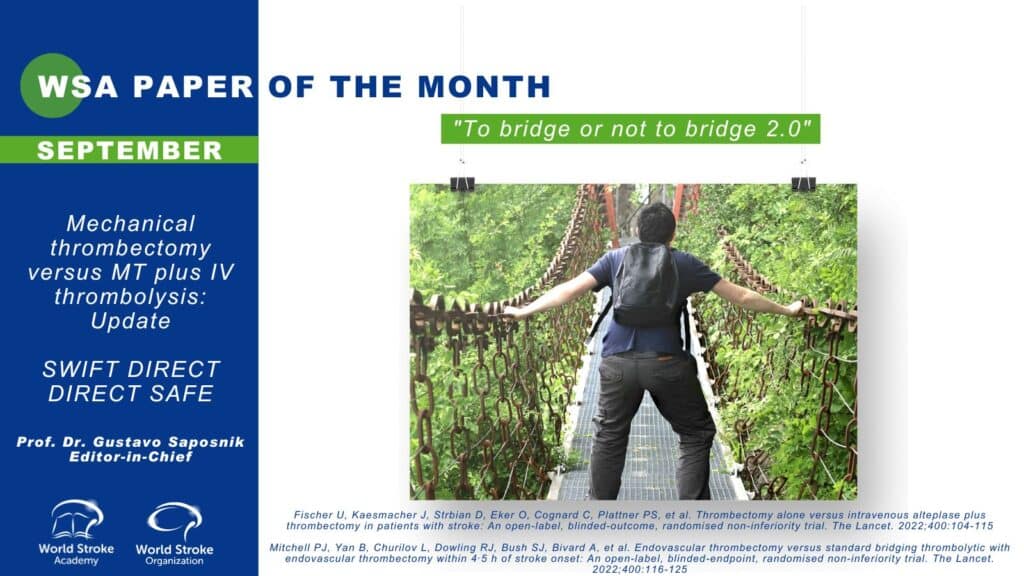The Paper of the Month – September
11 Sep 2022Mechanical thrombectomy versus MT plus IV thrombolysis: Update
Title: Mechanical thrombectomy versus MT plus IV thrombolysis: Update
Author: Dr. Prof. Gustavo Saposnik, Editor In Chief, World Stroke Academy
This article is a commentary on the following articles:
- https://www.thelancet.com/pdfs/journals/lancet/PIIS0140-6736(22)00564-5.pdf
- https://www.thelancet.com/journals/lancet/article/PIIS0140-6736(22)00537-2/fulltext
If there is one thing that is certain in medicine, it is uncertainty. If you want to do something to mitigate that uncertainty, you may become a trialist or practice the art of playing with odds based on the existing evidence. – Dr. Gustavo Saposnik
Commentary
This month we are highlighting the results of two similar randomized trials (SWIFT-DIRECT and DIRECT-SAFE) comparing whether the use of mechanical thrombectomy (MT) alone is non-inferior to MT plus IV thrombolysis (aka bridging therapy [BT]) for patients with anterior circulation large vessel occlusion (LVO) stroke.1, 2 Both studies were published recently in Lancet. The concept of non-inferiority was previously explained in a recent editorial. Some differences (e.g. prevalence of atrial fibrillation, baseline mRS, etc) can be observed when comparing baseline characteristics between these trials.
In an excellent accompanying editorial, Prof. Pooja Khatri summarized the history of trials comparing MT alone vs BT for LVO. As other therapeutics interventions in medicine, there has been a “pendulum effect”: a swing tendency between MT alone (supported by DEVT and Direct-MT trials) to BT (supported by SKIP, Mr CLEAN-No IV and the present studies).3-5
Overall, a higher proportion of patients achieved independency (mRS 0-2) at 90 days in the BT arm compared to MT alone (for SWIFT-DIRECT: 65% vs. 57%; adjusted risk difference −7·3%,
95%CI −16·6 to 2·1, p=0·12 and for DIRECT-SAFE: 61% vs. 55%; adjusted risk difference −5·1%, 95%CI −16 to 5·9, p=0·19).1, 2 In other words, these two trials consistently showed no evidence for omitting intravenous thrombolysis.
A meta-analysis comprising 41 studies (n=14,885 stroke patients) showed that BT provided a 29% higher likelihood of achieving functional independence (OR 1.29, 95%CI 1.16–1.44) and 25% higher chance of successful reperfusion (OR 1.25, 95% CI1.08–1.44), compared to MT alone.6 Interestingly, there were no difference in functional independence (OR 1.08, 95% CI 0.91–1.27) when analysis was restricted to these 6 RCTs (n = 2,333). There were no differences in safety outcomes with low rates of intracerebral hemorrhage. Of note, SWIFT-DIRECT and DIRECT-SAFE were included in this meta-analysis.6
WHERE DO WE GO FROM HERE?
The current evidence suggests that BT may be superior to MT alone for achieving functional independence and successful recanalization for patients presenting within 4.5 hours from last seen normal with a LVO in the anterior circulation.
TAKE-HOME MESSAGE
The likelihood of achieving independence appears to be approximately two-fold1, 2 higher with BT compared with thrombolysis alone (25-30%)7 and up to one-third (11-29%)1, 2, 6 higher compared to MT alone.
WHAT DO TO FOR THESE PATIENTS?
Together these trials contribute to reduce some uncertainties about the most likely beneficial treatment for patients with a LVO in the anterior circulation. You may want to weight some factors (e.g., time from LSN, thrombus characteristics, patients’ preferences, etc) when considering the best combination of acute reperfusion therapies.
Prof. Gustavo Saposnik
Director, Stroke Outcomes & Decision Neuroscience Unit
Unity Health Toronto | University of Toronto
Editor-in-Chief, World Stroke Academy
World Stroke Organization
References
1. Fischer U, Kaesmacher J, Strbian D, Eker O, Cognard C, Plattner PS, et al. Thrombectomy alone versus intravenous alteplase plus thrombectomy in patients with stroke: An open-label, blinded-outcome, randomised non-inferiority trial. The Lancet. 2022;400:104-115
2. Mitchell PJ, Yan B, Churilov L, Dowling RJ, Bush SJ, Bivard A, et al. Endovascular thrombectomy versus standard bridging thrombolytic with endovascular thrombectomy within 4·5 h of stroke onset: An open-label, blinded-endpoint, randomised non-inferiority trial. The Lancet. 2022;400:116-125
3. LeCouffe NE, Kappelhof M, Treurniet KM, Rinkel LA, Bruggeman AE, Berkhemer OA, et al. A randomized trial of intravenous alteplase before endovascular treatment for stroke. New England Journal of Medicine. 2021;385:1833-1844
4. Yang P, Zhang Y, Zhang L, Zhang Y, Treurniet KM, Chen W, et al. Endovascular thrombectomy with or without intravenous alteplase in acute stroke. New England Journal of Medicine. 2020;382:1981-1993
5. Zi W, Qiu Z, Li F, Sang H, Wu D, Luo W, et al. Effect of endovascular treatment alone vs intravenous alteplase plus endovascular treatment on functional independence in patients with acute ischemic stroke: The devt randomized clinical trial. JAMA. 2021;325:234-243
6. Trifan G, Biller J, Testai FD. Mechanical thrombectomy vs bridging therapy for anterior circulation large vessel occlusion stroke: Systematic review and meta-analysis. Neurology. 2022;98:e1361-e1373
7. Menon BK, Al-Ajlan FS, Najm M, Puig J, Castellanos M, Dowlatshahi D, et al. Association of clinical, imaging, and thrombus characteristics with recanalization of visible intracranial occlusion in patients with acute ischemic stroke. JAMA. 2018;320:1017-1026
Authors Video Interviews


